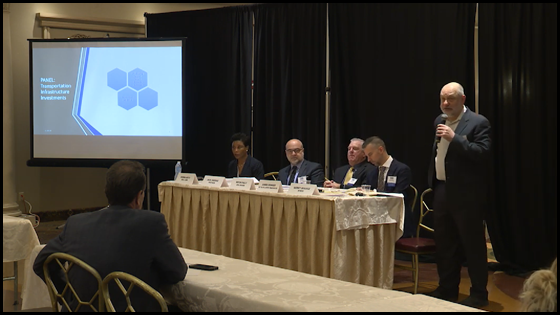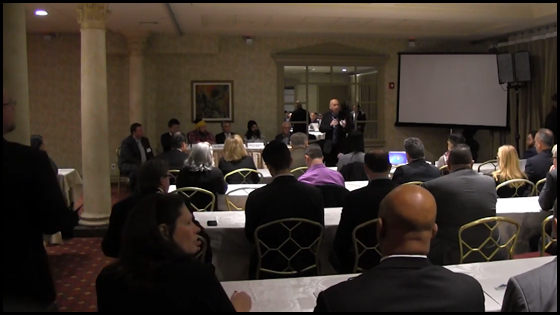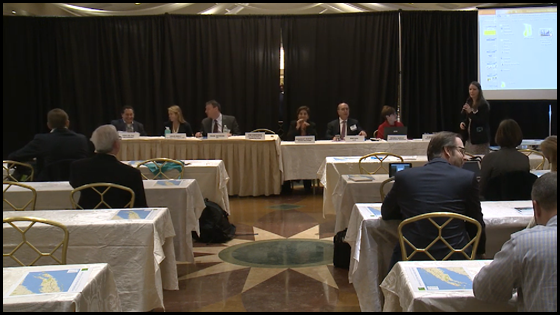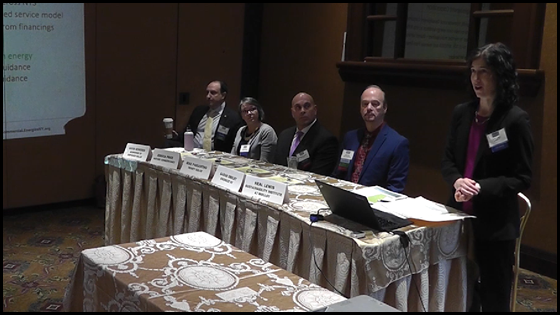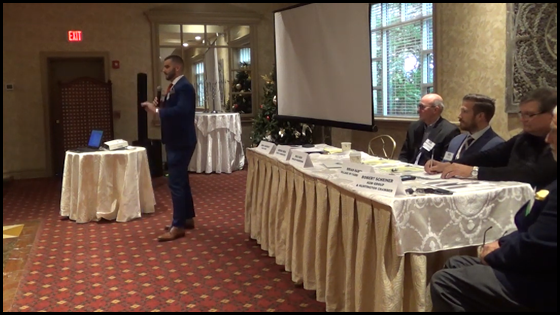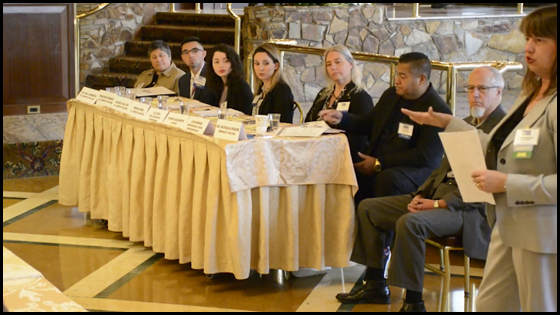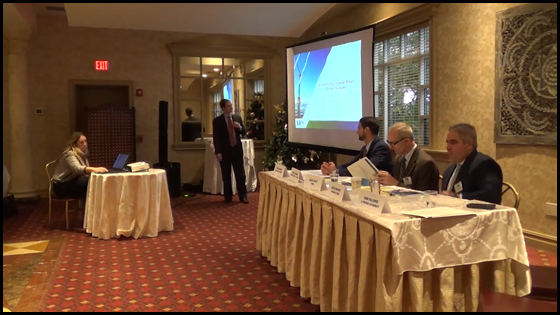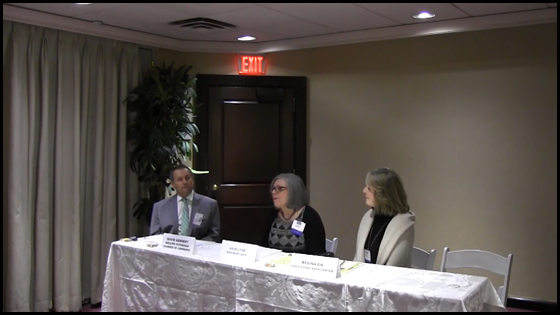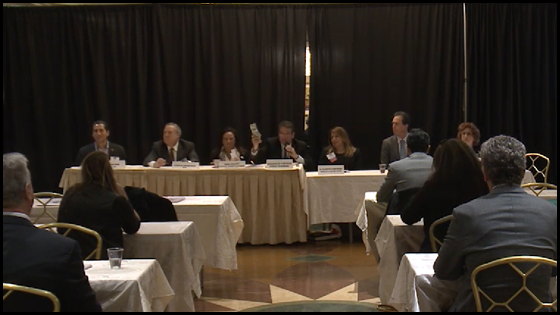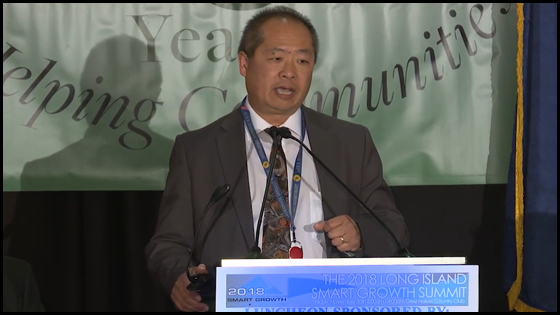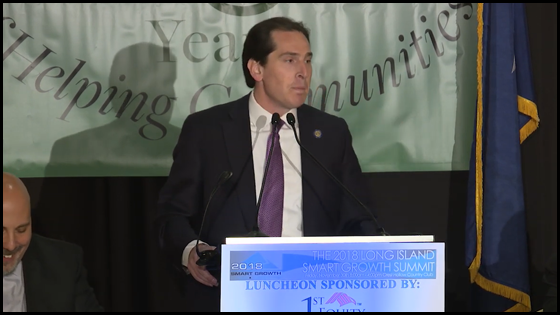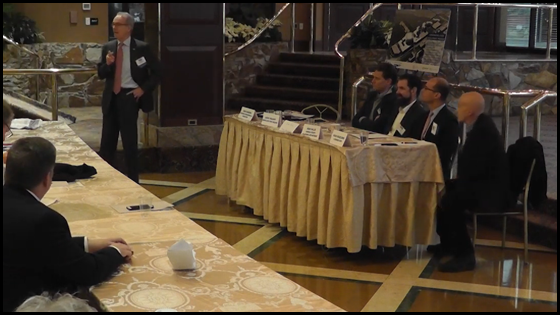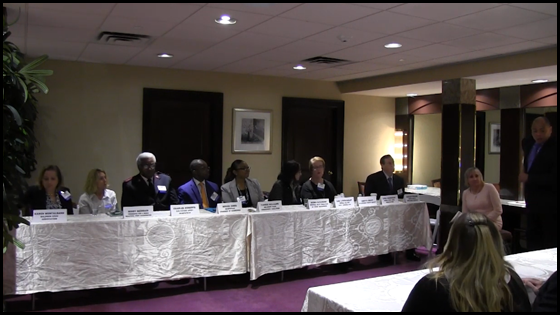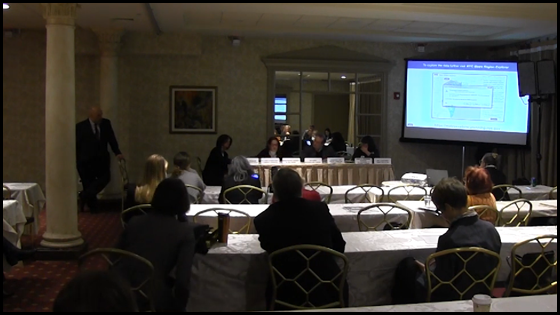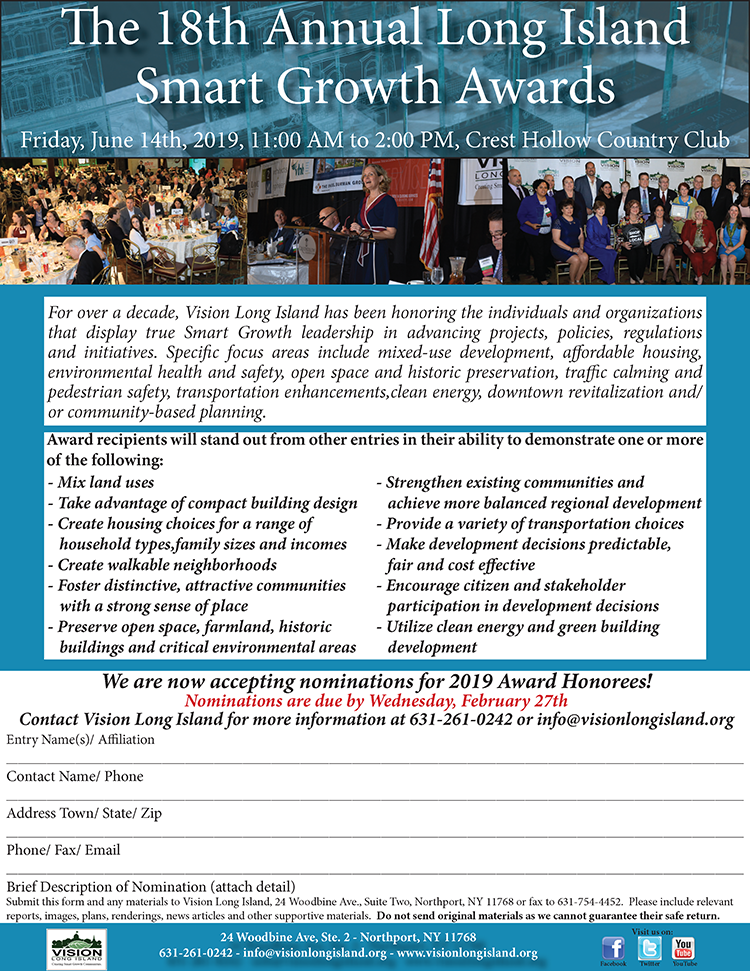
More than 1,250 Long Islanders join together
to plan
downtown revitalization and infrastructure!
Vision Long Island was proud to host the 17th Annual Smart Growth Summit, attended by over 1,250 business, community, and government leaders. The theme of Long Islanders coming together on a local level without the distractions of national and large scale divisions dominated the day. The day featured a morning plenary session, 19 excellent workshops on a wide variety of subjects, engaging speakers and experts, and great networking.
Over 135 speakers focused on topics related to downtown revitalization and infrastructure investment. Over 60 different Main Street redevelopment and water, sewer, energy and transportation projects were covered throughout the program. The event was also able to present a strong set of ideals for the future of downtowns, housing, environmental issues, transportation infrastructure, and jobs on Long Island.
Opening Remarks
This year’s Summit kicked off with one of the most highly attended breakfast sessions ever as the room was filled to capacity to hear the opening remarks and State of the Town and Villages panel. The session would open with the Pledge of Allegiance being led by Newsday’s Joye Brown.

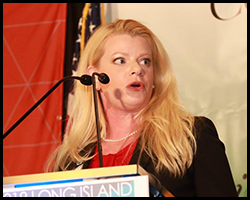

Eric Alexander, Director of Vision Long Island kicked off the day with a review of recent successful downtown and transit oriented development projects driven by community based planning. He also presented the themes of the day which were placemaking – essentially the need to not just focus on housing investments but jobs, public space, safe streets, new retail, arts, culture and other amenities. The second theme was local leadership which included the 40 civic and community based organizations in the room along with the 20+ chambers of commerce representing the downtown revitalization efforts across Long Island.
Amy Kramer from AT&T New York provided opening remarks demonstrating their company’s commitment to bringing technology to our downtown business districts. For the 4th year now they have sponsored the morning’s State of the Town’s and Villages panel and look forward to continued dialogue with local officials.
State of the Towns and Villages

The 2018 State of the Towns and Villages panel featured Town of Islip Supervisor Angie Carpenter, Town of Brookhaven Supervisor Ed Romaine, Town of Oyster Bay Supervisor Joseph Saladino, Town of Hempstead Supervisor Laura Gillen, Town of Huntington Supervisor Chad Lupinacci, Town of Riverhead Supervisor Laura Jens-Smith, Town of North Hempstead Supervisor Judi Bosworth, Town of Smithtown Supervisor Ed Wehrheim, and Village of Farmingdale Mayor Ralph Ekstrand.
The State of the Town and Villages panel opened with moderator Joye Brown of Newsday, now on her 11th year guiding this conversation, asking if it was easier for governments to get things done in recent years, or if it was the same. She followed that by asking if things were the same, drawing a tepid response from the officials, most of whom did not indicate one way or another.

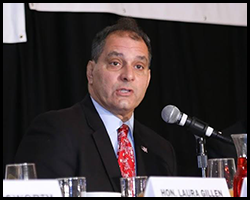
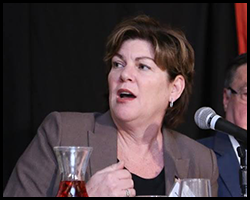
Supervisor Ed Wehrheim spoke first on that, noting that change has been going on in Smithtown since he took office, running through a number of ongoing projects. He would speak on the efforts for improved sewer infrastructure in local business districts, citing St. James, Smithtown proper, and Kings Park. He went a little more in-depth on Kings Park, noting that a pump station is shovel-ready and simply waiting for approval from the state. Zone changes have also been put into place that will allow for taller buildings in the Hauppauge Industrial Zone. He ended by pointing to 1.1 million square feet of commercial space in a form of development or approval, 800,000 square feet of which is currently underway.
Supervisor Joe Saladino spoke next on improvements in Oyster Bay, talking about how they have approved changes that have sped up the permit process for both residents and businesses. The Town has also become the top Long Island Town for solar applications and has been able to lower taxes to make it easier for new residents. Mr. Saladino would then talk about the Hicksville Downtown Revitalization process, and how they are trying to move forward with a TOD-focused plan surrounding the LIRR station.
Ms. Brown would use the subject of the ongoing revitalization to ask the panel if anyone was experiencing blowback from projects. Supervisor Laura Jens-Smith of Riverhead spoke at that point, talking about finding the balance for her Town’s rural roots and new development. She mentioned changes to Route 58, a regional shopping center, as well as revitalization efforts and new workforce housing in the downtown. The recent approval of 5-story residential buildings has seen some pushback, however, causing Riverhead to look into how best to spread out new housing to fit into the character of the area.

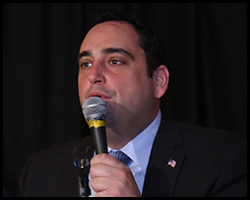
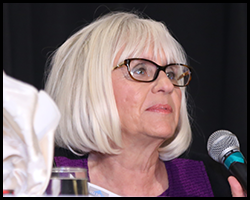
The conversation turned next to Nassau, with Supervisor Laura Gillen from Hempstead talked about both the Nassau HUB and Belmont projects, which are among the largest currently going on. Though they are still in the conceptual phase, the Town is trying to reach out to the community to make them part of the process before there is development. She noted the importance of millennial housing at the HUB, and how necessary it is for Long Island to have a place for young people to live if we’re going to get them to stay in the region. This makes it imperative to work with developers to create an environment to foster such housing to help keep not just younger people on the island, but their parents as well.
Huntington Supervisor Chad Lupinacci spoke next on the Town of Huntington spoke on the parking situation at the Cold Spring Harbor train station and how to improve it without adding a parking garage that the public was against. He talked about a grant received from NYS, of which $7 million would go to Cold Spring Harbor for station improvements. The plan will be to use the money for the solution, including possibly a minor parking structure or purchasing land surrounding the station. He also indicated that Huntington is in talks with the local civic on solutions.
North Hempstead Supervisor Judi Bosworth talked next about progress at New Cassel, including the groundbreaking on a 77-unit affordable housing senior unit. This came as a result of a new zoning change that allowed the acreage to be reduced from 5 to 2 and lowered the cut-off age for seniors to 55. Supervisor Bosworth touched on the revitalization efforts centered on the Yes, We Can Community center. She also spoke on issues surrounding parking and how difficult it can be when there’s no public will for a garage or asphalting over acres of property. One solution is to change commuting habits, such as shuttles and other alternate ways to get people to the train station.

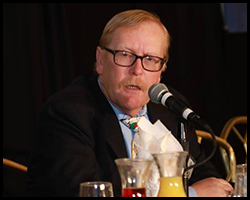
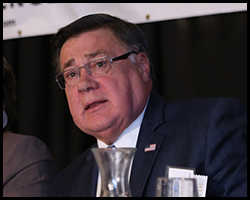
Town of Islip Supervisor Angie Carpenter expressed appreciation at finally receiving the $10 million DRI grant for the Central Islip area after three years of trying. She talked about investment in the surrounding area creating a sense that it was the right time for Islip to receive funds to help revitalize as well. She noted the numerous projects underway in the Town that are bringing revitalization, but that this particular area had been neglected for far too long. The process is still in the beginning phase, but they have already begun to reach out to the community and working through the process. She ended by talking about downtown Bay Shore and how the Town has been making strides in creating a destination in the community.
Farmingdale Mayor Ralph Ekstrand spoke next on his thriving downtown and the newly formed Merchant’s Association. He also announced to the room that they are in the beginning stages of creating Long Island’s first Business Improvement District in years as an effort to sustain the success. Farmingdale is also looking for opportunities to make the 109 corridor into an area that is 100% affordable housing ranging from 50% to 80% of median income. Such a move would help to keep young people local, and draw them to the Village area. Mayor Ekstrand also talked about possibly using the LIRR station for parking solutions with the idea of using shuttles from the lot during evenings and weekends being floated. The idea of 100% affordable housing in the 109 corridor led to a brief aside on the need for such housing in the area and how it might help to lead to some young people moving out of their parents’ homes.
Brookhaven Supervisor Ed Romaine was up next, giving updates on new housing at the Yaphank Meadows as well as the Ronkonkoma HUB, which should see its first section completed in the spring. The completed HUB section will bring 500 new units to the community when completed. Hundreds of units are also in the works across several projects spearheaded by Concern for Independent Living as well as D&F Development. Those projects both promise to be 100% affordable housing for Brookhaven residents. Supervisor Romaine also noted that housing is not the whole story but tie into interconnected issues including transportation, government, tax burden, and climate change. He also called for modernization of transportation systems, specifically electrification of the LIRR. Mr. Romaine also talked about the need for solid waste solutions as we begin to face increasing challenges in dealing with that issue. He called for Long Island to work as a region to come up with equitable answers and to implement them as a whole area and not disparate municipalities.
In light of changes to recycling programs across the region, the discussion turned towards solutions. Supervisor Carpenter spoke on how proud she was of her Town’s recycling program, which resisted switching to single stream. She then pivoted to the idea of how tax revenue is spent, consolidation, and how Towns are going to need to make some tough decisions, especially within school districts.
Moderator Brown then moved on to multi-family housing and how there seems to be a demand for it in spite of opposition. The general consensus is that while multi-family housing is rising in demand it isn’t slowing the market for single-family homes. Supervisors and Mayors all gave updates on projects underway that will increase housing stock while stating that single-family homes are still very popular with residents.
Some of the issues brought up that fed into that were how intertwined parking and housing is and that a successful downtown will need to find a way to incorporate both of them. There was also the challenge of striking the right balance where housing can be developed in downtowns without losing the charm and aesthetic that residents have grown accustomed to in their villages. Aging in place was also discussed and how it was important to provide services for seniors as well as millennials wishing to stay on Long Island.


For the next part of the discussion, Alejandra Micardo-Suarez from Amityville High School was able to ask what the local government can do for environmental issues including water pollution and flooding and what’s being done to focus on these. She brought up the plastic bag fee and asked when Nassau would follow suit as well as what can be done beyond that. Initiatives discussed included Hempstead’s re-opening of a water lab as well as seeding local waters with filter-feeding shellfish to increase both water quality and industry. The Nassau County Villages are also exploring possible bans to waste plastics, including straws, utensils, bags, etc.
Amityville student Tyrone Taylor asked the next question of the day, noting that he’s going to college and will probably need a student loan, which will make his return to the region much more difficult. He asked what is being done to help that situation. Solutions discussed included redefining what affordable means since a narrow definition doesn’t quite fit the housing spectrum that can change depending on a person’s expenses and living arrangements, such as a roommate. Also, there was a discussion on getting local corporations and businesses to invest in housing and help attract new employees.
Finally, Ms. Brown brought up the recent elimination of the SALT and the effects it has on local budgets. Supervisor Romaine answered, noting that the area will be impacted negatively by the issue and that it is essentially a penalty for having a government that invests in local infrastructure. Supervisor Bosworth also noted that residents are having a much tougher time selling their homes due to the elimination.

Vision Long Island would like to thank all of the Elected Officials who participated on the panel as well as Dr. Nathalia Rogers of Berkeley College for bringing a number of students and young people to participate in the event. bringing a youthful perspective to the panel.
View the Morning Plenary Session here.
Zoning Codes and Design
for Walkable Places

This panel on codes, moderated by Keith Archer of Harras, Bloom and Archer, dealt with the different types of codes available and how they can be used to shape and encourage development. The panel was asked if enough was being done and things are moving quickly enough, or does zoning need a complete overhaul.
Marwa Fawaz of VHB discussed the multiple planning projects going on in Baldwin including the Downtown Commercial Corridor Resiliency study that was recently completed and the Grand Avenue redesign as well as the zoning overlay district currently being developed.
John Chillemi of Ruskin Moscou Faltischek noted that we are making progress, but maybe not enough. He noted that Hempstead has floating TOD zones to allow flexibility and have been used. A similar strategy is being used in Amityville. More does need to happen, not a complete overhaul, but these flexible overlays are beneficial in specific areas.
The panel was also asked how the new codes affected LI in a positive way. Sal Coco from BHC Architects noted that these projects couldn’t have been done with variances, they needed new or overlay zone to make them possible. Wyandanch and Copiague have developed new codes, and now Westbury is undergoing the process. We have to streamline the development process in order to get things built. He highlighted BHC’s work in the Wyandanch project, which created a walkable plaza near the train station and in Copiague where two buildings were created with a public plaza between them. He also mentioned how the Village of Lindenhurst worked with the developer to create an overlay district that was buildable. In Westbury, the code being developed will include areas with different heights and densities depending on the surrounding context.
Marwa noted that there has been an acceptance of density as these codes are created, but walkability is what can really make it happen. Complete Streets can promote safety, economic development, and encourage walking. Grand Avenue is difficult because it is a county road with significant truck traffic. What is proposed is not a reduction in the road size, but a re-striping to give space for cyclists and pedestrians making it safer. They are also adding street trees, rain gardens for drainage and beautification.
Chris Stoddard from Harrison Design stressed the importance of architects and engineers working together. He proposed setting buildings back slightly from the front yard line in order to allow more sidewalk space for sidewalk cafes and activity.
Keith then asked the panel if we are doing enough to create enough housing. What’s next? What more do we need to do? Marwa noted that areas near the train station makes rezoning easier because there is less resistance. The station is an asset. Sal also noted that many of those areas are underutilized with low industrial development that is in poor condition.
Micro-apartments were mentioned as a possible solution for the need for housing, however none are currently known on Long Island. Two bedroom units designed for roommates are another suggestion. They can serve a purpose, maybe a temporary purpose, to jump-start a career, but there were concerns of community resistance.
Discussion about why many places are using overlay codes instead of form-based code centered around the additional flexibility of an overlay district where a form based codes has less flexibility. However Chris noted that Euclidean zones are restrictive by saying you can’t do certain things, where form-based codes restrict you by saying you must do certain things, they are just restrictive in the opposite direction. Form-based codes have been used in Wyandanch, Hempstead Village, and Riverside and require certain architectural standards. With both types of zoning, most projects aren’t approved “as of right” the reviewing boards will still have the ability to help shape them.
View the
Zoning Codes and
Design
for Walkable Places Panel here.
Transportation Infrastructure Investments

The Transportation Infrastructure Investments panel covered a topic that is drawing increased national attention in recent months. The panel was comprised of Jack Khzouz from NICE Bus, James Bonner from NY & Atlantic Railways, Mitch Pally from the MTA Board, Donna Betty from the MTA/LIRR, and was moderated by Gerry Bogacz from NYMTC. Mr. Bogacz opened by covering the elements of funding for transportation infrastructure and the status of local, state, and federal funding streams.
Donna Betty covered the East Side Access and the infrastructure involved in completing the project. The new access tunnel will allow for a greater number of Long Island commuters in and out of Manhattan, make for quicker commutes, and make state-of-the-art system upgrades. She also noted that the train station is an economic engine for the region and that the project will help to improve that. Ms. Betty would conclude by talking about other new infrastructure projects such as improvements to the west end concourse and Moynihan Station, centralizing the train control station, electrification of the central branch, and train yard expansions.
Mitch Pally added to Ms. Betty’s presentation by talking about a couple of other infrastructure projects, including electrification of Ronkonkoma to Yaphank to help modernize a major part of LIRR’s line. He also spoke about the need for electrification from Huntington to Port Jefferson, which would be a substantial investment with a big return. The project would also allow for the building of a much-needed yard along the line to be able to better store empty train cars. Full electrification will also allow for a commuter to go to any LIRR station and take a train all the way into NYC.
The next panelist was Jack Khzouz, who discussed infrastructure priorities for NICE Bus. He began by mentioning that NICE’s role was to help grow and support economic growth, local ridership, and the railroad. The support for the LIRR comes in the form of relieving parking issues, which can cause an immense amount of money, at stations. To this effect, NICE is launching shuttle services for local stations, which will be cheaper than parking. Mr. Khzouz noted that investment in the system with upgraded technology will help NICE to “match the seat to the need” and support other forms of transportation.
The final presenter was James Bonner from the NY & Atlantic Railroad, who started by pointing out that most people are unaware that there is a dedicated freight railroad on Long Island. The company moves products that touch a variety of industries, and has made it a priority be as environmentally friendly as possible. This includes a new type of locomotive referred to as Tier 4, which expels air that is cleaner than what is drawn in by most counts. Though not as visible as other transportation services, NY & Atlantic is an economic driver which serves to remove some freight traffic from local roads. He also covered the major projects that are connected to his company, some through public funds and projects and others through private investors as well as NY & Atlantic itself.
The audience was then given the opportunity to ask questions, covering the need for current bus service to support local train stations, how micro-transit fits into the current picture, long-term expansion goals of local rail networks that are focused on Long Island and not NYC, and how to raise the profile of busses to more as part of system as opposed to the last resort.
View the Transportation Infrastructure Investments Panel here.
Food, Drink, and Downtowns

Dave Winzelberg of LIBN moderated this panel that highlights the importance of the food and drink industry to downtown vibrancy and the issues that owners face.
George Hoag from Brickhouse Brewery spoke about when he opened in Patchogue in 1994 and how there were only two restaurants on Main Street. Now there are well over twenty restaurants. There’s more competition, but also more customers. Residential development and being in a village with sewers has helped the growth. John Murray from Kilwins spoke how downtown retail has also grown with the increase in restaurants with lots of specialty shops.
Evan Chen of TOA Fusion spoke how they decide which locations to move into. They look at the local population and incomes. Originally Farmingdale was very empty and not as desirable of a location, but now busy with lots of foot traffic, activities and events. Joe Abruzzo Jr. of WA Meadwerks remarked that when they looked at Lindenhurst, there were vacancies, but when they spoke to the Village they learned about all of the things they are doing that will help to revitalize and they wanted to be a part of that.
Don Chiavetta of the Campagne House has been a resident of Bethpage his entire life and felt that it could handle another restaurant. They wanted outdoor dining to add that experience, but it’s been harder since Bethpage isn’t an incorporated village. The zoning needs to change to make projects feasible. Arsalan Pourmand of Flux Coffee in Farmingdale looked at different villages to decide which was most suited to the type of coffee shop that he wanted to open.
The panelists were then asked what obstacles they faced when trying to open their business. While some had no complaints, others had difficulty getting utilities hooked up and others had difficulty navigating the permitting process in the Village. Some felt that the Village was helpful, but you have to follow the rules and get all your permits.
They were also asked what has been the most helpful which had a greater variety of responses. George, Joe and John felt the Villages were the most helpful to their business while others found support and partnerships with other local businesses and developing a following or community of customers around their business. Word of mouth, local diversity and foot traffic as well as local Chambers of Commerce were also cited.
Finally, the effect of the internet on their business was asked in light of the recent Amazon HQ2 announcement. Some are still figuring out if Uber Eats and Door Dash are worth the cost and others also sell, or are looking to sell, their product online in addition to their Main Street location. Social media is used by most of the panelists and they use it to not only build a customer base and hear about what’s new in their industry, but also advertise live music and other special events.
View the Food, Drink, and Downtowns Panel here.
Complete Streets and Pedestrian Safety

The Complete Streets and Pedestrian Safety panel spoke about a wide range of issues relating to how our streets are designed. The panel was moderated by Vision’s Placemaking Director Elissa Kyle and included speakers on public health, transit advocates, transportation engineers and an agency representative. Michele Gervat of the American Heart Association spoke of how our health has been adversely impacted by how active transportation has been removed from our lives and many find it hard to get the recommended amount of physical activity that used to be just part of our daily routine. Streets that are safer for those on bike and on foot can help more people get more activity into their daily routine.
Ron Roel with AARP discussed how Complete Streets can affect our ability to age in place. Seniors are 50% more likely to be involved in a pedestrian crash so roads need to be made safer for seniors to have greater mobility. What’s good for seniors is good for everybody, including families and lower income communities allowing better options for all. Rosemary Mascali of Transit Solutions spoke of how Complete Streets and transit can work together. Streets that are safer and more comfortable for pedestrians are correlated with two to three times higher levels of transit usage, the first mile and last mile of a trip getting between transit and the destination affects how accessible and useful the route is.
Current projects underway on Long Island were the topics of the next three speakers. Tom Temistokle from New York State DOT highlighted some of the projects that they are working on as a part of the Governor’s Pedestrian Safety Action Plan. Long Island received $25 million for eligible improvements out of a total of $110 million statewide with half going to DOT and half to local governments. Projects include Main Street in Huntington, 25A through Miller Place and Rocky Point, SR25 corridor in downtown Greenport, new signals in downtown Hicksville and numerous individual intersections across the island.
Frank Wefering from GPI discussed the downtown Lindenhurst Walkability Study currently underway. The study involves participation through walk audits along Wellwood and Hoffman as well as online maps where residents and businesses can share thoughts and comments on individual locations around the Village and view before and after renderings of possible improvements. Grace Healy of the Trust for Public Land spoke about the Empire State Trail Extension to connect Long Island to the Empire State Trail that will connect individual trails across upstate from the city to Buffalo and the Adirondacks. The route will connect from the city to the east end with many segments of the trail off road and close to downtowns and train stations.
Finally, Greg Del Rio of Sam Schwartz Engineering talked about emerging trends and technologies that are changing how we think about transportation in the future. Car, bike and scooter sharing as well as pedal assist electric bicycles are expanding the options we have for transportation and allowing us to rethink our roadway design and reclaim our public rights of way.
View the Complete Streets and Pedestrian Safety Panel here.
Solar and Renewable Energy Opportunities

The Solar and Renewable Energy Opportunities panel hosted a discussion on the future of renewable energy in our region. Moderated by Neal Lewis of the Sustainability Institute at Molloy College, the panel of experts also included David Schieren from SunPower by EmPower Solar, Mike Passantino of Trinity Solar, Jessica Price from the Nature Conservancy, and Sarah Smiley from Energize NY.
The panel opened with Mr. Schieren from SunPower by EmPower, who gave a presentation on what his company has been doing to achieve a vision of renewable energy on Long Island. He cited the recent government report on climate change, noting that it has become a crisis, and how clean energy can go a long way in addressing that. However, there is a need to deliver it cheaper and more efficiently to make it more attractive to the general public. Mr. Schieren also talked about the need for NYS to accelerate its efforts to implement renewable energy as well as some of the programs currently out there. He wrapped up his presentation by talking about how solar batteries work.
Sarah Smiley talked about Energize NY, her not-for-profit development corporation, which helps local municipalities and businesses to make environmentally friendly upgrades to existing buildings. They do this through methods that include providing capital to help with that goal. Tools available include Property Assessed Clean Energy, or PACE, which covers 100% of the upgrade and is repaid through an annual charge on tax bills. The program covers a wide variety of improvements and upgrade methods, is flexible on term length and interest rates, but is not a bank loan and automatically transfers to a new owner.
Trinity Solar’s Mike Passantino spoke on his company’s work. As a national company, they have grown throughout the Northeast to become the second largest renewable company in the country. He talked about the challenges to growing on Long Island as compared to other parts of the region, noting a sense of skepticism from residents. He emphasized the need for education and partnership in communities to help grow solar as a viable energy source for reducing cost and increasing efficiency.
Jessica Price was the final speaker and covered what the Nature Conservancy has been doing to help promote renewable energy and climate resilience on Long Island. She talked about her organization’s “Solar Roadmap” and their efforts in the area. She tied climate change to conservancy, her organization’s main purpose, and how it’s becoming a challenge for society as a whole. She talked about sources of carbon emissions and downstate’s contribution to that as well as what can be done to reduce that. Ms. Price also covered plans and opportunities put forth by Long Islanders to help meet the 50% renewable energy goal by 2030 that Governor Cuomo has called for. She noted that the Nature Conservancy is working to bring major players together to better serve the region for the future.
Neal Lewis took a moment after the presenters to speak about the Sustainability Institute’s upcoming white paper that will make a recommendation to Towns and Villages to require new commercial buildings to be built with solar. The discussion then turned back to the panelists as questions were covered on a wide variety of topics including challenges within the industry and ways to accelerate growth, the role of generators and battery technology, net metering for residential customers, the permitting process, changes to local code to promote solar, the pace of technology, and possible new incentives.
View the Solar and Renewable Energy Opportunities Panel here.
Waste Management and
the Regional Recycling Crisis

The Waste Management panel comes at a time when our region is experiencing a number of urgent issues concerning recycling programs in our region. Expert panelists included Charles Vigliotti from American Organic Energy, Stanley Lomangino from Maggio Environmental Service, Gary Rozmus from GEI, and moderator Adrienne Esposito from Citizens Campaign for the Environment.
Mr. Lomangino was the first presenter, starting by discussing Maggio’s role in waste management on Long Island. Part of ongoing issues include the recent tariffs being imposed by China as well as quality issues with the type of cardboard being recycled. Transportation has also been an issue faced as Maggio tries to process and move waste. A number of other issues include federal regulations, logistical issues for hauling waste, and a reversion from single-stream to dual-stream by municipalities. The reversion of single- to dual-stream due to market factors has been a particular focus in the region lately.
GEI’s Gary Rozmus was the next presenter, speaking on strategies and regulations for promoting soil reuse. He covered new regulations in the industry, the first in almost 25 years, and what benefits they have. These new regulations allow for the reuse of materials that previously had to be shipped out and disposed of with new fill imported. Companies are now more able to plan how best to reuse those materials thanks to the changes while also reducing solid waste that needs to be disposed of. The changes have also allowed for the use of fill material from an expanded, but still regulated, set of sources.
Charles Vigliotti of American Organic Energy (AOE) talked about food waste, which comprises approximately 17% of solid waste across the US. His company is working to change uneaten food from a waste to a source material. His company has been able to market millions of tons of organic waste as compost and soil products that go back into local lawns. A big development in their business model is the development of an anaerobic digester, currently under development and preparing to break ground in the next 6 months, which will take tons of food waste from local resources and turn it into a clean energy source.
The conversation then turned to how recent changes in China’s regulations for recycled materials have caused a backup of shipped products and lowering of demand. This has caused issues with single-stream recycling as an industry in recent months. The discussion also covered the need for public education and engagement as well as the creation of local markets for recycling. Questions also included tops that ranged from specifics on AOE’s new anaerobic digester, efforts to reduce food waste at the source, fluctuations of the recycling market and how it affects the product, research of new types of sustainable plastics and efforts to change people’s behavior, and the need for more recycling options for public and commercial buildings.
View the
Waste Management
and
the Regional Recycling Crisis Panel here.
Parking Management
for Successful Downtowns

The Parking Management for Successful Downtowns panel featured a discussion on one of the more prevalent issues downtowns are dealing with today. Solutions for parking are being implemented all across the island in downtowns that are on the rise and this panel featured people both in search of solutions and implementing them. Panelists included John Yancigay from Qwik Ride, Gerard Giosa from Level G Associates, Dale Koch from Bohler Engineering, Brian Harty from the Village of Farmingdale, and moderator Robert Scheiner of H2M Architects + Engineers and the Huntington Chamber of Commerce.
Mr. Yancigay started the panel by talking about the success of Qwik Ride in downtowns and how the shuttle service has been making strides to bring free shuttle services to local downtowns to help alleviate the need for parking. He covered how they are working in their newest downtown, Huntington Village, as well as next steps to give riders more options when using the service.
Gerard Giosa spoke on how his company, Level G Associates, has been working in growing downtowns to solve parking issues as well. Part of those solutions include regulation of the parking supply to accommodate demand, noting that parking meters seem to be the go-to choice for downtowns. He talked about elements needed to put together a parking management plan in downtowns. These include accurately measuring parking occupancy and turnover, balanced enforcement of parking regulations, communicating, being open to change, signage, a regularly updated and accurate website, regular internal reports, and the most important one, leadership.
The next speaker to present was Dale Koch from Bohler Engineering, who talked about changes in downtowns concerning parking as well as what Bohler has done to help with parking for their retail clients. As an engineering firm, they have spent the last 30 years trying to meet the goals of both their clients and the municipalities they’re located in. Mr. Koch noted that there are new challenges even after all these years, especially when considering the rise of mixed-use in downtowns.
The final panelist was Brian Harty, who talked about how the parking demand is being dealt with during Farmingdale’s recent boom. He noted that just 10 years ago there was not a parking problem in the Village, mainly due to it not being a destination. Farmingdale worked to create a welcoming environment, slowing ticketing and working to rebuild parking facilities that had fallen into disrepair. He also talked about other solutions including making use of existing parking that is being underutilized during peak recreation hours, creating new parking lots, and reducing ticketing to focus more on safety and less on technicalities.
Mr. Scheiner cited his experience with the Huntington Township Chamber of Commerce and some of the discussions on how to improve parking through ride-sharing and shuttle services. Huntington has been examining the feasibility of a new, centralized parking structure that could help to reduce traffic and free up some of the more remote parking lots for new development opportunities.
The audience then had an opportunity to ask questions, with the discussion centered on the fact that limited parking can limit growth in downtowns and how the need to learn and innovate was a big part of moving forward. Huntington was held up as an example of a downtown who is bringing in merchants to try and finance new parking solutions and create a buy-in and help mitigate cost to the taxpayer and local residents.
There was also talk about code enforcement to ensure that parking doesn’t illegally bleed into residential areas as well as the cost of public parking pay stations in downtowns and how well they work. Some also asked about whether there was a thought to encourage people to park in less dense areas to encourage the use of shuttles and reduce downtown parking issues. There was also talk about compact car parking as well as the process involved when conducting parking studies and what kind of housing is considered.
View the
Parking Management
for Successful Downtowns Panel here.
Long Island Youth Job Opportunities

This panel, hosted by Vision board member Dr. Nathalia Rogers of Berkeley College was focused on determining what are young people’s expectations of the workplace and with a tight job market, what are employers doing to attract talent? The panel included students from St. Joseph’s College as well as representatives from different fields and organizations.
Dr. Gail Lamberta, the St Joseph’s Associate Dean for Community Development, introduced herself and explained the other roles she fills at the school including experiential learning programs, bridge programs for high school students, continuing education programs as well as teaching in the recreational leisure studies program.
Jonathan DiMaria, a hospitality and tourism major at St. Joseph’s, is also participating in an internship with Dale Carnegie and hoping to get his credentials as soon as possible to begin working in the field. Rachel Sullivan is a psychology major with a concentration in industrial organization and a second major in philosophy and religious studies who is working with her professor on practical applications of psychology research. Briana Henn is a senior currently working on an internship in therapeutic recreation and looking to get into the field as soon as possible.
Liz Uzzo, the Human Resources Director for H2M Architects and Engineers noted that they are continuously looking to grow the group. They have grown by 100% in the last 5 years and do work in both the private and public sector.
Luis Mendez is the former director of the Nassau County Office of Minority Affairs and one of the founding members of Empowering Young Professionals. Their mission is to hold government accountable to ensure that job opportunities that are created, impact and benefit diverse communities.
Peter Goldsmith of LISTnet, explained that they are a chamber of commerce for the tech industry on Long Island with a goal of having Long Island be a center for tech companies. Two years ago they opened a “WeWork” for tech companies called Digital Ballpark, and are opening another in Wyandanch near the train station.
Dr. Rogers asked the students what they are looking for in a work environment. Jon is looking for a creative, open space, where there is collaboration with other people, not someplace where he’d be stuck in cubicle. Rachel mentioned a company that was supportive of continuing education, flexible around classes, maybe offering tuition assistance, someplace open to new ideas and thinking. They were also looking at 24 different character strengths and a focus on quality of life, not quantity
Liz mentioned that H2M recently opened an office in New York City because many of their younger employees wanted to be in the city and the company didn’t want to lose them. They are offering a flexibility of workplace, with the same features in different offices allowing people to work on laptops, where they are comfortable. Peter discussed how smaller companies like to collaborate together and the Digital Ballpark allows 24 companies to collaborate, have social events to network and share ideas.
The panel discussed the challenges of bringing more diversity into the workforce, particularly in industries that are traditionally white and male. Liz discussed how H2M participates in career fairs and connects with universities as well as offering more flexible work schedule to allow mothers to manage a better work-life balance. Luis suggested reaching out not just to universities but to high school students to create a “farm team system” for those who may not be suited for college but may find their niche in other careers. He also mentioned how Community Benefit Agreements (CBAs) can be used to help residents in underserved communities get training to improve their employment opportunities. Peter mentioned they are starting program called Grit, geared towards recognizing individual talent to help minority tech startups.
The panelists were also asked about how students can prepare themselves for employment. Gail discussed how getting a comprehensive education with roots in liberal arts can give you skills that can be applied towards many careers. She also suggested experiential learning, internships and other ways to work with professionals in the field. It was also mentioned that students that have jobs while in school tend to be more successful than those who had the best grades.
Then the discussion turned to salaries and the students were asked what kind of starting salaries they were looking for. They felt that it’s more important to look at what the job entails, not just the salary. The working environment is more important than the salary as long as there’s enough to live on. Some said they would take a lower salary if the employer helps pay for grad school or if there is opportunity for growth. However it was mentioned that it’s hard to live onan entry-level salary.
Finally the panelists were asked what their wishes are for the next generation or what they should know. Liz felt that they get a lot out of younger generation, they’re creative and innovative, but that they need to ask. The message was to let employers know what you want and that you won’t get it unless you speak up.
View the Long Island Youth Job Opportunities Panel here.
Long Island’s Energy Future

This year’s Energy Future panel featured a discussion among panelists assembled from a variety of energy sources with Mike Deering of LIPA moderating and speakers Tom Falcone of LIPA, Keith Rooney of National Grid, Mike Voltz of PSEG, and Clint Plummer of Deepwater Wind/Orsted.
Mike Deering opened the discussion by noting that energy production is in a paradigm shift at the moment with the rise of renewable in both the region and nation. He would then turn the conversation over to his colleague Mr. Falcone, who spoke on LIPA’s current role as owners of the electrical grid and how they interact with other regional players, regulators, and energy providers to improve and better connect consumers. He also spoke on how they’ve been working for years to try and improve customer satisfaction and increase the value of the delivered product. Part of that was investing back into educations and the electric grid with new infrastructure and upgraded technology.
Keith Rooney was the next speaker, who covered National Grid’s role in providing gas to customers on Long Island. Mr. Rooney covered the technology and investment that the company has put into local infrastructure in order to import natural gas to the region. He also covered ongoing projects to rebuild the system for the next 100 years and merging control centers to increase efficiency as well as investments meant to raise efficiency in the area. This comes at a time when the demand for gas on Long Island has been rising, making it more necessary to improve infrastructure to meet the rising need. He also noted that the company has worked to bring relief to those who need it most with a consumer advocacy center that helps low-income individuals pay their energy costs.
The next speaker was Mike Voltz from PSEG Long Island, who is the operator of the electrical grid owned by LIPA. He talked about efforts to improve reliability and keep building out a clean and efficient grid. He talked about how that works in conjunction with Governor Cuomo’s goal of 50% renewable energy by 2030. Some of this is incentives to customers to reduce energy consumption and investments in the form of programs aimed at helping reduce strain on the demand. He also noted that PSEG is working with Deepwater/Orsted to connect offshore wind power on the grid. He also covered efforts to reform the utility company after partnering with LIPA after Superstorm Sandy.
The final panelist to present was Clint Plummer from Deepwater Wind/Orsted, who spoke on the perspective of a renewable energy developer and why they think the business makes sense as part of the local electric grid. He started by covering the history of his company in the region, one with a dense population and a high energy demand. This is part of what brought them to Long Island to help create a cost-effective solution for energy needs on Long Island, a region that needs such a solution.
The Q&A section of the panel featured a discussion concerning the cost of power and what’s been done to address it in recent years, the functionality of new “smart” technology, the timetable for changes in rates and reduced consumer costs, and the renewable energy goal specifically for Long Island in the context of NYS’ 50% by 2030 goal.
View the Long Island’s Energy Future Panel here.
IDA, PILOTs & Financial Impacts

The IDAs, PILOTs, and Financial Impact panel included several members of IDAs from across Long Island as well as representatives from law firms that work closely with such organizations. Panelists included Richard Kessel of the Nassau County IDA, William Mannix of the Town of Islip IDA, Kelly Morris of the Suffolk County IDA, David Leno of Rivkin Radler, and was moderated by Sean Cronin of Cronin & Cronin Law Firm.
Mr. Cronin opened by asking the panelists what they see as the role of the IDAs on Long Island. The Town of Islip IDA’s Bill Mannix spoke first, noting that they are creations of NYS and function to contribute to the health and growth of the region they serve. He noted that the mandate is broad though the organizations are mostly focused on providing economic advantages and incentives to industrial companies, which can range from taxes to industrial equipment to real estate. Islip specifically is trying to advance publicly stated policy goals of the Town board either through the town’s master plan or otherwise.
Kelly Morris spoke next, representing Suffolk County’s IDA. She stated that IDAs are public benefit corporations with a mission to serve their communities. On a county level, the IDA works with Town IDAs to help advance their goals, working together as partners to provide necessary benefits and work out best practices in order to advance Long Island’s economy.
The next panelist to speak was David Leno from Rivkin Radler, a firm that works closely with applicants to local IDAs. He reiterated that the IDA works as a partner with communities in the form of three main benefits: Payment-in-lieu-of-taxes (PILOTs), exemption from sales tax, and exemption from mortgage recording tax. He also noted that PILOTs are one of the more valuable tools that IDAs wield due to real estate taxes being one of the biggest hurdles to new businesses on Long Island.
Richard Kessel was the final panelist, who talked about the changes to the Nassau IDA and efforts to transform it into a more transparent and effective body. He listed three goals of the IDAs including attracting new business to expand the tax base, fighting to keep local businesses from leaving, and creating affordable workforce housing. Mr. Kessel emphasized the third goal of affordable housing, especially in terms of transit-oriented development, noting that creation of new housing would allow for an expanded workforce and tax base to help create a healthy local economy.
The panel would then open up the discussion to include a variety of subjects on how the IDAs effect local businesses and municipalities. Panelists discussed how IDAs work to accommodate the need for housing, the evolution of their roles throughout the years, how they work to retain existing businesses while also working to attract new ones, the process applicants take to receive benefits, and efforts to educate the public.
View the IDA, PILOTs & Financial Impacts Panel here.
Arts, Music & Placemaking

Visual and performing arts provide an anchor to downtown business and help reinforce a sense of place. The Arts, Music & Placemaking panel, focusing on the importance of the arts in communities, was comprised of Regina Gil, Gold Coast Arts Center, Julie Lyon, Westbury Arts and David Kennedy, Greater Patchogue Chamber of Commerce, Moderator.
To punctuate the importance of arts in building up communities, David Kennedy looked to the rebirth of the Patchogue Theatre for the Performing Arts. The theatre, once an abandoned movie theatre, was restored in the late nineties. Kennedy drew the correlation of a vibrant Patchogue directly to the theatre’s revitalization. The decline of Patchogue, he noted, began when the theatre closed and the rise of Patchogue began when it was restored. Prior to its restoration, Kennedy pointed out there were about three restaurants in town, now, there are over thirty. Another entity that brought a new sensibility to downtown redevelopment was the formation of the Patchogue Arts Council. It was these successes that led to a unique development in Patchogue called Artspace. Patchogue is the only Long Island community that hosts an artist’s residential community. Kennedy summed up the importance of art. It is essential in creating an identity of a town.
Julie Lyon explained that the goal of Westbury Arts, a non-profit arts council, is to attract, develop and promote art and cultural events in the community. The council’s motto is “Together We Create Westbury.” One important reason for its inception was to support downtown revitalization. It was created in the wake of the success of The Space at Westbury. In its five short years, membership has seen an increase of 70%. Lyon credits the work of dedicated volunteers and a successful digital infrastructure. Westbury Arts engages in a variety of unique events, including a summer arts and concert series, pop up galleries, summer fine arts camp for children, art contests and more. Next year promises to bring even more events. “Out Of Many, One” will be featured. It will consist of themed art events that coincide with Black History Month, Women’s History Month, LGBT and Hispanic Pride. Also, in 2019 the council hopes to realize its first brick and mortar home in the community. In 2016 the Village was awarded a ten million dollar downtown revitalization grant from Governor Cuomo. The Village has allotted much of that money for a building that will raise Westbury Arts to a new level.
Arts can be a facilitator for a restored and revitalized downtown, Regina Gil of Gold Coast Arts Center told the audience. Gold Coast received ten thousand dollars in 1989 from the State as seed money and, by 1995, the Arts Center found a home in the basement of a local church. Two short years later, it moved to its present home, a 5,000 square foot building in Great Neck. Gold Coast presents art exhibits, summer arts and vacation arts for children, and in 2011 founded the Gold Coast International Film Festival. Gil stressed that the arts are not just entertainment, it goes hand in hand with social services. Gold Coast works with Alzheimer’s patients, creating music experiences to help them connect with family members. Gold Coast also works with local schools, teaching the teachers to use art to reach those students that are hard to reach.
All three panelists agreed that art brings boundless positive influences to communities, but they also agreed that finding funding is a challenge. Grants, banks and individual donations are a few ways to find necessary dollars to keep the arts alive.
Audience questions were spirited. STEAM education (science, technology, engineering, the arts and math) was discussed, including its potential as another funding source. The need to reach out to young people, and diverse populations was stressed. As Gil noted, art is a unifying force if you allow it to be, going way beyond today’s tribalization.
View the Arts, Music & Placemaking Panel here.
Economic Outlook for Main Street
Office, Residential & Retail

Warren Strugatch of the Long Island Press introduced the panel topic by highlighting the idea of “live, work, play” communities, which had been largely absent on LI. He also talked about how Northwell Health being selected as employer for Nassau Hub development creates a prime employment center in the area. However, there is still a need for updated office space in local downtowns to help local businesses that are important to the revitalization of downtowns as opposed to just larger ones like healthcare.
The first panelist was Vision board member Steve Kreiger of Engel Burman. They built the Bristal on Post Avenue in 2001, but today feels that multifamily apartments would be better for that site in the downtown. While it does have an economic multiplier effect, it doesn’t attract millennials to downtown. He also noted that they got approvals from the Town of Hempstead on Tuesday for 180 units of non-age restricted housing cater to millennials. They are designed as two bed, two bath units with common space and separate leases which will offer a more affordable housing.
Michael Puntillo of Jobco Realty spoke about five national issues and how they will impact our local economy. The first is Federal fiscal policy, the GDP is positive, but starting to slow a bit. The second is trade, the recent rewrite of NAFTA looks like will be positive for the US. Third, regulatory policy on the federal level, which has been rolled back a bit. Banking industry loosened regulations which have increased lending. Fourth is infrastructure, the country needs comprehensive infrastructure policy. New York State is out ahead of the country, but one is needed for the country. Finally, interest rates will likely raise in December, but it will be data-dependent on economic conditions. We’ve gotten used to a low rate environment and increases will impact construction.
Guy Canzoneri of Five Point Real Estate, remarked that they are strong believers of downtown development. In order to create offices for the "live, work, play" environment, there is a need to create mixed-use buildings and a social Main Street with retail and restaurants, but in many cases we are losing offices being converted to apartments. We need more downtown offices, but they are hard to build new and are not economically viable. Municipalities need to look at zoning to allow office space without losing yield of apartments which make projects viable. Downtowns need daytime employees to support downtowns during the week, not just evenings and weekends.
Russel Helbling of Sabre Real Estate Group highlighted how retail is important to creating a sense of place. Sabre is working on a number of large projects, and were part of an earlier team for the Nassau Hub. They are currently working on the Seritage project in Hicksville. The goal of this development is to provide a place to go on a Saturday, where you go to eat and find other things to do while you’re there. To create a place for residents of the surrounding community as well as new residents. Existing downtowns are great, but much of new development is creating new downtowns.
Nick Strachovsky of KOW ARMA Building Consultants, which provide risk assessment and oversight of large projects, noted how they get an overview of what others are doing. They find that communication, coordination, and flexibility are crucial to getting projects built. Put together a team to make things work with architects, engineers, and builders that work well together. He sees an opportunity to bring in more retail if people can live upstairs or nearby, however Long Island needs better infrastructure for things to succeed.
The panel was asked if they were optimistic or pessimistic about the market for downtowns on Long Island. Panelists ranged from “cautiously optimistic” to “bullish” and commented on the need for infrastructure. They also discussed how retail isn’t dying but changing, and how numerous online retailers are now opening up brick and mortar showrooms for their products.
There was also discussion of the gap between what developers are doing and what the community knows. Many public hearings are during the daytime when people can’t attend and all they hear is density. Panelists noted a need for a balance between urban and suburban density and that municipalities need to take the lead on redevelopment. There needs to be a better structure for developers to come in and know the rules.
Finally, the panel wrapped up with a question about how can supportive housing and social services be integrated into communities where they have walkable access to jobs. The panelists noted that density is needed to allow different levels of affordability, and they can be designed to work together successfully.
View the
Economic Outlook
for
Main Street
Office, Residential & Retail Panel here.
Water & Sewer Infrastructure Funding

The Water and Sewer Infrastructure Funding panel covered one of the more important subjects facing any municipality looking to expand: how best to pay for needed sewer capacity to increase density. The panel featured experts with experience ranging from environmental to development concerns and included Peter Scully of Suffolk County, Mario Mattera from Plumbers Local Union 200, Alan Weland from Suez, Maureen Murphy from Citizens Campaign for the Environment, Ali Chaudhry from AECOM, and moderator Roger Clayman from the Long Island Federation of Labor. Mr. Clayman noted that this subject is of particular importance to the labor movement due to the importance of its members who often have strong ties to their local communities.
He turned to Ali Chaudhry of AECOM about his company’s experience with infrastructure funding and how important water is to development. He noted that there is a context in history here and how New York used to be on the cutting edge of infrastructure 100 years ago. That’s changed due to a number of factors, including reprioritizing of funding, and has led to a reduction of investment. Governor Cuomo has made strides to change that recently, however, by initiating one of the largest infrastructure funding programs in the country. This is necessary thanks to a reduced federal role for infrastructure funding in the face of how expensive and necessary the infrastructure is.
Citizens’ Campaign for the Environment’s Maureen Murphy was the next speaker, talking about how her organization has worked in sewer issues with a goal of helping to ensure clean drinking water for local residents. This makes it important considering how Long Island gets a majority of its drinking water from aquifers, making the issue of how we take care of treated and raw sewage important for a healthy environment. Improper treatment and excessive dumping have led to a rise of toxic algae blooms, or “tides,” in local bays as well as thick, choking vegetation on beaches. This creates a need for new technology and infrastructure to clean discharge water and lobbying efforts to increase funding for infrastructure on the federal level.
Suffolk Deputy County Executive Peter Scully talked about his 35 years of experience in government working with wastewater infrastructure. He noted Suffolk County’s efforts to address wastewater issues in the area in face of what is considered a “historical mistake” of developing the region without a sewer network. The current approach to address this includes innovative alternative septic systems, creating wastewater systems for neighborhood clusters, and creating new sewers.
He also echoed the sentiment that more investment from the federal government is necessary for wastewater infrastructure as well as a need for a stable revenue stream for improvements. He would go on to cover current funding sources as well as costs involved in upgrading the existing systems with and without grant funding. His presentation also covered new grants made available by Suffolk to help residents upgrade their septic systems, which has proven to be successful and popular, as well as what they’ve done to cooperate with other states to implement solutions.
Alan Weland spoke next, representing the global water company Suez that was hired by Nassau County to operate and maintain the sewer system. He talked about what his company is doing in Nassau and how they’ve been trying to improve water quality, especially in the wake of Sandy. Investment has been focused on recovery and resiliency to help avoid further catastrophes. He pointed to the Bay Park facility’s new floodwall and electrical distribution improvements above that wall, which is set a 500-year flood level, as examples of resiliency improvements.
This is all part of ongoing efforts that also include innovation at the Cedar Creek Plant to help increase ability to clean effluent from treated water and better distribute volume among treatment plants, decommissioning of the Long Beach treatment plant and building a pump to move the water away from the Western Bays, and improvement of energy efficiency.
Finally, Mario Mattera from the Plumbers Local Union 200 talked about how important sewering is for the local residents and his union members specifically. He held up the new Riverhead treatment plant, the only one of its kind in the state, and how it cleans discharge water along with the need to recapture that water to help keep rates low. While it’s important to clean discharge, it is just as important to replenish local aquifers. He also commended efforts in Nassau to look at that while noting that we’ll need more of the same across Long Island.
Mr. Clayman went on to take questions for the panelists, who covered subjects that included how Huntington Station fits into current plans for the future, the possibility of public-private partnerships for infrastructure, what restraints Suez has as the operator of Nassau’s sewers, the impact of private wells on water infrastructure.
View the Water & Sewer Infrastructure Funding Panel here.
Resources for Main Street Business

Bob Fonti, Vision board Co-Chair and Co-Chair of the Suffolk County Alliance of Chambers, began the workshop with introductions of both the panelists and the audience members, followed by a session of “Did you know?” where each panelist quickly highlighted a specific resource available.
Gina Coletti, of Suffolk County Alliance of Chambers of Commerce spoke of the Suffolk County Downtown Grant program that is offered each year. There is $400,000 in the budget for this year and a training session in January. Josh Bienstock of NYIT mentioned that the School of Management offers complimentary teams that will come to your workplace and focus on issues facing your company. Paul Quintero from Accion USA spoke about how they can help businesses access between $500-$250,000 of capital through his organization. Elizabeth Custodio of People’s United Bank highlighted their website for small business with different products and services and also that they can meet with you to discuss your business idea even if you’re not quite ready for lending services yet. John Keating from PSEG-LI discussed several programs for businesses that can help them lower utility bills.
The panelists then spoke in greater detail about what is available and what services they provide.
Paul discussed the customized ways for businesses to access capital, from the food industry to child care services. Josh’s team recently worked with a salon to set up a social media campaign, another set up an employee handbook, membership and customer retention faculty and student teams. Conflict management, organizational skills, team management workshops
Gina explained how the SCAoC works with individual chambers to find out what their issues are- downtown revitalization, insurance expenses etc. They also work with Constant Contact to educate business on how to take advantage of online marketing.
John showed PSEG’s recent advertisement for the Main Street Revival Program which is designed to help businesses fill vacant storefronts on Main Streets. Up to $100,000 which helps during the first year of business when getting established. Other programs include rebates for energy efficient lighting and programs where
Francesca Carlow of the Nassau Council of Chambers of Commerce aired the NCCC’s recent “Shop Local” advertisement which highlights the benefits of shopping local including tax revenue, supporting local communities, and other benefits.
Finally, during the question and answer period, Bob and Francesca provided updates on the internet sales tax bill status and the benefits of requiring out of state online vendors to collect sales tax on purchases made in New York as well as the small business savings accounts legislation. With new representation in Albany, there may be new opportunities to get them passed.
View the Resources for Main Street Business Panel here.
TOD & Downtown Revitalization Projects

Projects near transit and in downtowns across Long Island are helping to revitalize and strengthen commercial centers and surrounding neighborhoods. Speaking on the TOD and Downtown Revitalization Projects panel was Anthony Bartone from Terwilliger & Bartone Properties, Rob Gitto from The Gitto Group, Nick Halstead from Mill Creek Residential Trust, Alan Handelman from Conifer Reality, Ryan Porter from Renaissance Downtown, Andrew Zucaro from Zucaro Construction and Moderator Judy Lynn Simoncic from Forchelli Deegan Terrana.
Starting off the panel was Anthony Bartone who discussed the downtown revitalization of Farmingdale, including his company’s luxury apartment rentals, The Cornerstone at Farmingdale. Bartone labeled the village’s revitalization efforts a success, noting rental vacancies are at almost zero percent and retail rents are surging. The latter leading to retail reinvestments into storefronts. According to Bartone, revitalization is infectious. In 2006, TOD was pioneering, today, it’s all the rage. Bartone pointed out TOD is no longer an idea based on statistics, it’s now a reality based on facts. Terwilliger & Bartone’s newest project, The Cornerstone in Lynbrook, is in the application phase. It is walkable to Lynbrook’s downtown center and railroad. An ambitious project, it is projected to be completed in 2021.
Ryan Porter explained that Renaissance Downtown has revitalized communities through the use of public/private partnerships. With over twenty million square feet of development in New York, Renaissance believes in working from the ground up, not the top down. The company works with civics and business, building trust. This community-based revitalization approach allows all stakeholders to get on board early in the process so as to avoid challenges later on. They also engage in community benefit agreements which lead to such projects as community gardens, artwork and education. Another unique aspect to their work is their ability to create form-based codes in house. It is important to create zoning code that is flexible over time. It needs to be resilient in order to change as the market changes. Renaissance’s projects on Long Island include Hempstead, Huntington Station, Southampton and Huntington.
With a four state footprint, Conifer Reality owns over 15,000 units of housing, including senior housing in Patchogue, Coram, West Babylon, Copiague and Riverhead. Discussing the Riverhead properties, Alan Handelman described forty five units with an artists’ presence. The key to what Conifer does, according to Handelman, rests on the use of low income housing credits and community investment funds. These are described as very important tools in the company’s toolbox, along with local community participation.
Mill Creek Residential Trust is presently working on its 4th major TOD, located in Mineola, across from the Courthouse, near the railroad and Winthrop University Hospital. According to Nick Halstead, the project boasts a two building format with multiple courtyards. Modera Metro, when complete, will have four levels of residential, off street parking and be designed to function as one community.
Rob Gitto, of The Gitto Group, describes the company as a family business, with most of its properties in Long Island and the Boroughs. The company has had great success in Port Jefferson and Port Jefferson Station, creating rental apartments with retail components in walkable communities. The residential units feed off Stony Brook University, catering to students with such amenities as gyms and screening rooms.
Andrew Zucaro discussed his company’s success in TOD beginning almost eighteen years ago in Westbury. Today, they have projects in Farmingdale, Patchogue, Hempstead and Amityville. The latter project consists of residential units next to the train station. Zucaro described the distance between the lobby and the trestle as about fifty feet, making it very desirable for the New York City commute.
Questions and comments from the audience were varied. Anthony Bartone discussed the issues of taxes and traffic, calling them problems on Long Island that Smart Growth tackles. By putting people close to transit, to downtowns, the need to use cars is lessened and local economy is helped. Bartone closed by saying we are educating our children on Long Island and they are leaving because they can’t afford to purchase a house. Rentals, near transit, near vibrant downtowns, are more affordable for these young adults and this adds a different perspective, allowing them the choice to stay.
View the TOD & Downtown Revitalization Projects Panel here.
Networking Luncheon

Lunch began with an invocation by Pastor Charles Roberts of the Salvation Army.
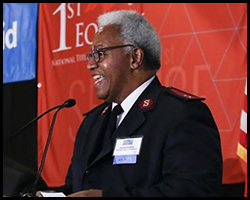

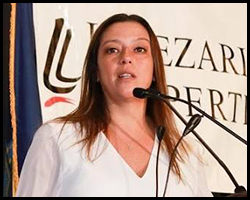
Long Island Railroad President, Phil Eng spoke on the importance of communication and finding solutions that work with the Smart Growth, downtown revitalization and transit-oriented development on Long Island. He stated that LIRR is working to modernize and ensure that the railroad is reliable and safe, while being proactive instead of reactive to potential issues. He also spoke of their success in completing the Second Track Project fifteen months ahead of schedule, and the progress being made on the Third Track which many thought could never get done.
The next portion of the lunch program saw the room hearing from new leadership in the State Senate, with both State Senator Todd Kaminsky and State Senator-Elect Monica Martinez speaking. Senator Martinez spoke about looking forward to January and working across the aisle in the interest of Long Islanders. She also noted that, with many significant development projects in her district, she will be working to secure funding for needed infrastructure.

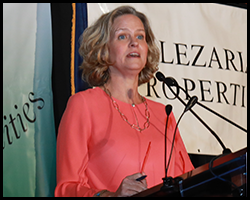

State Senator Todd Kaminsky spoke of being excited to work with the new members of the Senate, Jim Gaughran and Kevin Thomas, Monica Martinez, and exiisting Senator John Brooksand all Senators to get things done for Long Island in a bipartisan fashion. He struck a cooperative tone by stating that while this year the people wanted something different, it wasn’t about ideology so much as getting things done. He reminded the crowd that state elected officials do not own Albany, and none of them own the seat to which they are elected.
Nassau County Executive Laura Curran spoke next, thanking Vision for our advocacy for transit-oriented development and the many elected officials and mayors across the island getting things done. She spoke of the agreement between RXR and Brooklyn Sports Entertainment for the Nassau HUB and the selection of Northwell Health as an anchor employer for the development. The County is busy securing state funds for infrastructure, and is working with the town and other stakeholders to move forward with the agreement. There are more details to be worked out, but this is the next step. If we get this done, she said, it will show the world that Nassau County is open for business and ready to embrace the future.
Maribeth Pietropaoli of First Equity Title and Pink Tie was the next speaker, highlighting the work they are doing to help give back to communities through their Give N Go gas stations and other charitable endeavors that bring resources directly to local communities.
A video presentation on PSEG-Long Island’s Main Street program was shown that highlighted local investments in downtown businesses that are providing jobs and filling needed vacancies.
While State Comptroller Tom DiNapoli was scheduled to speak, but he was unable to come to the event due to a comptrollers forum upstate. He did share a video, however, thanking Vision and speaking on how Long Island has been successful in coming together to solve our challenges to build up trust and improve transparency in local decision making.
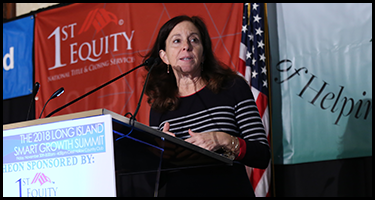
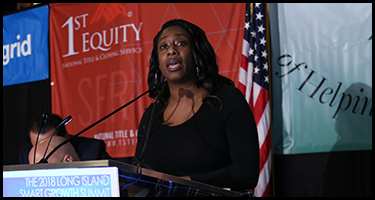
Adrienne Esposito from the Citizens Campaign for the Environment also Co-Chair of the 100 member LI Lobby Coalition spoke on this years LI Lobby Day outlining past successes in water, sewer, transportation, housing investments and legislation as well as our upcoming agenda this legislative session.
Vision’s Assistant Director Tawaun Weber reminded the crowd about the upcoming LI Smart Growth Awards in June and the importance of a range of programs in store for 2019.
Finally Suffolk County Executive Steve Bellone spoke about the importance of planning with local communities and Suffolk County’s investment in infrastructure, particularly sewers. He ended his remarks with a call to action on a referendum on sewer investment to be held on January 22ndseeking to expand Suffolk’s wastewater capacity in select communities.
View LIRR President Phillip Eng's remarks here.
View NYS Senator-Elect Monica Martinez's remarks here.
View NYS Senator Todd Kaminsky's remarks here.
View Nassau County Executive Laura Curran's remarks here.
Major Development Projects

The Major Development Projects panel was filled out by experts representing some of the largest projects being planned on Long Island. The panel included John Cameron of Cameron Engineering and Associates, David Wolkoff from Heartland Town Square, Chris Kelly from Tritec Real Estate, Sean Sallie from the Nassau County Planning Department, and moderator David Winzelberg from Long Island Business News.
John Cameron spoke first, talking about the Ronkonkoma HUB and the process his company took as part of a JLL development team to create a project that would serve the community and help grow the tax base. The community was very involved in the project, working with the municipality to come up with a wish-list for the site that was then brought to the County. A request for proposals was then issued, which Cameron responded to with a plan that incorporated the community’s requests with a tax-positive plan that includes a new arena, the only one in a 30-mile radius, as well as several large employers and new job opportunities for the area.
Chris Kelly spoke next, continuing on the subject of the Ronkonkoma HUB, with Tritec developing another portion of the site, with Phase 1 getting underway in 2017. This includes 489 units across 6 buildings on the easternmost side of the site that will be ready for leasing around the end of April into May. He noted that the company is excited for the other part of the HUB to be developed as a regional project that will benefit Long Island as well as Tritec’s project. He noted that the project should help to raise the profile of central Long Island, something that local residents are very interested in.
David Wolkoff was the next speaker, talking about Heartland and the ongoing process of getting the mega-project built. The TOD project finally had part of the first phase approved in Islip after 15 years and will include 1,500 residential units, 400,000 square feet of retail, and 200,000 square feet of office. While financing multi-family housing has become easier in recent years, Mr. Wolkoff noted that what’s really needed is a balance in development, one which Heartland is trying to strike by building more than just residential units in the first phase. He also commended the Town of Islip for their work in advancing the regionally important project.
Sean Sallie then spoke, talking about the Nassau HUB and how it has transformed from a military-industrial site to one of community importance. This importance has made the site into one ripe for a transformational project that can reap benefits for the entire County. The 72-acre site has been drawing increased attention since 2011 with several different proposals considered in that timeframe. He noted that Northwell’s recent commitment to creating a life sciences medical center will be critical to moving forward with development. Committee meetings and reviews are expected in the coming weeks to discuss amendments and approvals that will move the project forward.
The discussion then turned to the different hurdles between residential and office space requirements to get off the ground, especially with the need to have “anchor” employers very early in the approval process. There was also discussion on how RXR was selected as the developer for the Nassau HUB, the timetable involved for the Ronkonkoma HUB on both the arena site and residential area, the need for new sewer infrastructure at Heartland and how it’s affecting the timetable, the role of smaller projects and how they tie into major projects.
View the Major Development Projects Panel here.
Strategies for Affordable Housing

The Strategies for Affordable Housing panel strived to find common-sense solutions for the need for affordable housing in our region. The robust panel included Tracey Edwards from Habitat for Humanity Suffolk, Dr. Richard Koubek from the Suffolk County Welfare to Work Commission, Ian Wilder from Long Island Housing Services, Peter Florey from D&F Development Group, Jim Speer from LI Board of Realtors and New York MLS, Michael Rooney from MDG Design + Construction, David Gallo from Georgica Green Ventures, and moderator Peter Elkowitz from the Long Island Housing Partnership.
The panel opened with a video covering the topic of Long Island’s housing needs and how they have evolved over the years from its original single-family bedroom communities to today’s needs. It also covered how to best reach out to local residents to ensure that affordable housing is not seen as a detriment to their neighborhoods. Especially in light of a younger population often burdened with debt who is not looking to purchase single-family homes such an expensive region.
Ms. Edwards spoke first, talking about her history as a former elected official and someone who has been a housing advocate for most of her career. She noted that often times projects are talked about in the abstract before applications come in, allowing for misinformation. What could help to counteract that is to educate and talk about the need for this type of housing in communities, targeting the surrounding area of the proposed project.
Dr. Koubek was the next speaker, who has been a longtime advocate of affordable housing in his various posts and professional career. He talked about how the Welfare to Work Committee has worked to provide housing for underprivileged families. Part of that was a report on the lack of affordable housing for working-class people. He spoke about how affordable housing is a necessary component of helping to lift families out of poverty.
Peter Florey from D&F Development spoke next on his experience working with local communities to bring rentals to communities. Specifically, he worked on the process it took to bring Highland Green co-op, which was developed with a thought to make it palatable to local residents. The project presented a model where residents were co-owners, but with costs comparable to rentals. This removed landlords from the picture and put control of the units in the hands of the residents. The project was unique d helped to bring affordable units to a more affluent area of Long Island. This comes at a time when communities with a high concentration of affordable housing are trying to slow such projects in their area.
The next speaker was David Gallo from Georgica Green Ventures, which has built affordable housing in a number of communities, who talked about the role that tax credits can play in that process. He noted that tax credits are a way to shift the risk involved in building affordable housing. Credits are awarded through a process set by the state and can then be sold to banks for more equity and less debt. That increased equity then allows the developer to charge less for rent even though the cost of construction is the same as an average project. Guidelines do allow the developer to reap a profit, but at a reduced rate based on most of the construction costs.
Michael Rooney from MDG Design + Construction, who played a role in the revitalization of Harlem, was the next speaker and noted that they have found a niche in affordable housing. He talked about how community engagement has become a bigger challenge with the rise of affordable housing on Long Island, with residents wary of new developments that they believe might hurt property values or burden local school systems. A part of their job has become educating local communities and reaching out to them and local governments on what would be most desirable. MDG has found that listening to that feedback tends to create more successful projects.
Jim Speer from LI Board of Realtors and New York Multiple Listing Service (MLS) was the next speaker. He started by explaining how the MLS is working to create a more connected housing market in the region. He then noted that affordable housing can have different definitions depending on the area based on a number of factors. He also remarked that there are other factors and variables that are creating upward pressure on housing prices in the Long Island market. He said that a number of programs are out there to help people buy new homes.
The final presenter to speak was Ian Wilder from Long Island Housing Services, who spoke first on fair housing and what his company does to help promote that in the area. The mission of his organization is the elimination of unlawful housing discrimination and the promotion of safe and affordable housing. They believe that people should have the freedom to live where they wish without impediments put in place based on arbitrary reasons. Part of this is providing housing for millennials and the underprivileged in a wide variety of areas and not just small pockets on the island. He also noted that part of this is counteracting methods and code words employed by local municipalities to restrict access to minorities.
The panel was then opened up to questions which included queries on the new MLS system and houses listed on it, ways to keep costs of ownership level once residents move into an affordable domicile, whether the definition of affordable is actually affordable for a majority of Long Islanders, housing opportunities for the future that can incorporate a birth-to-death lifestyle, legislation concerning accessory apartments on residential properties.
View the Strategies for Affordable Housing Panel here.
Community Leadership

Local leaders shared thoughts on how to improve their communities, and it all starts with common ground. Panel members discussed the keys to moving great projects forward. The panel featured Lionel Chitty, Hicksville Chamber of Commerce moderator; Karen Montalbano, Baldwin Civic Association; Linda Henninger, Kings Park Civic Association; Mindy Germain, Residents Forward; Charles Roberts, Salvation Army of Hempstead; Dennis Jones, Hempstead Chamber of Commerce; Tammie Williams, Belmont Park Community Coalition; Debra Cavanagh, Central Islip Coalition of Good Neighbors; Gail Lynch-Bailey, Middle Island Civic Association; and Charles Voelger, Mastic Beach Ambulance Company.
When you talk about Smart Growth and the desire to improve communities, Lionel Chitty and Linda Henninger stressed the importance of civic engagement and consensus building. In both Hicksville and Kings Park, it is important for residents and business to work hand in hand in order to achieve agreement as to what the community finds acceptable for every revitalization project. Reaching that consensus can be done many ways, and is not only achievable but necessary in areas that have multiple stakeholders that may have different views or goals.
Charles Voelger described the importance of the Mastic Beach Ambulance Company’s efforts in building personal relationships with local community groups in order to garner support for its new facility. By interacting with the community, even on unrelated issues, the organization is able to build trust and engage in honest communication with all residents. It was noted that even though every community organization has their own goals, finding common ground can only help ensure that most get some rather than all get none when it comes to advancing projects.
Karen Montalbano and Mindy Germain discussed various ways to jump-start revitalization and economic growth. In Baldwin, these measures included revitalizing the civic association and using social media to ultimately pave the way for its Complete Streets Project. In Port Washington, the community organization utilizes surveys to reach residents that may not be able to attend meetings, understanding that most want a seat at the table.
Dennis Jones discussed how although the community had a large amount of buy-in towards redevelopment, but felt that projects have been stalled due to changes in the political landscape, emphasizing that community support needs to drive the process. Charles Roberts noted that community givebacks to better the quality of life are important in order to move any development ahead and to keep the character of the community intact.
Although there may be unique challenges in different communities, such as environmental challenges in Middle Island and language barriers in Central Islip, each panelist agreed that if communities can find common ground, identify problems, and work together to problem solve, projects and progress can move forward. Tammie Williams addressed community opposition to the proposed project in Belmont Park. She finished by stating that community development is not a quick fix, it is building communities, from the ground up.
View the Community Leadership Panel here.
Regional Jobs & Planning Outlook

Regional Jobs and Planning Outlook focuses on how trends in jobs, housing and other issues in the broader New York Metro region affect us here on Long Island. The panel was moderated by Vision Director, Eric Alexander and included Carolyn Grossman Meagher from NYC Department of Regional Planning, Larry Levy of the National Center for Suburban Studies, Sol Marie Alfonso-Jones of the Long Island Community Foundation and Randi Shubin Dresner of Island Harvest.
Carolyn began with a presentation of data from around the region which showed four significant trends. First, job growth is not occurring evenly throughout the region, but is concentrated in New York City. While the city has 40% of employment in the region, it has seen 75% of the growth since the great recession.
Second, office jobs which typically have higher wages, are concentrated within the city while suburban counties are relying more on local service jobs.
Third, the labor force, especially younger workers, are concentrating in NYC and inner parts of New Jersey. While historically more people have moved from NYC to the suburbs, Long Island in particular, recently the number moving from Long Island to the city has almost matched the number moving out. Young worker growth has declined outside of New York City except for specific location such as Stony Brook University and others.
Fourth, changes in the workforce and employment patterns are creating a geographic imbalance that will impact long-term planning and commuting patterns. While half of regional GDP is in the city and half is outside the city, and housing regionwide is half rental and half ownership, however most rentals are in the city or along rail lines in New Jersey and other suburban counties.
Does this contradict the narrative that taxes are driving people away?
Larry Levy noted that taxes are less of an issue than in the past. Ethics and infrastructure are the primary issues now, but if the housing market collapses, it will be taxes again.
Long Island has a $200B economy, with 106,000 businesses and $60000 average individual wages. There has been a tripling of engineering grants on LI. There has also been a paradigm shift since the recession. While it was about getting more jobs anywhere, now it’s about filling the jobs-high tech businesses which are having a hard time finding qualified people. We still have the highest rate of segregation despite our prosperity, with the poverty rate at a historic high. In addition, labor force participation is declining among those without a high school diploma. More than 140,000 jobs were created, but only 70,000 housing units created.
Long Island needs a holistic approach to achieve each of the state’s strategic pillars of innovation, placemaking, workforce development, and tradable sectors. We can’t create an innovation ecosystem without more top-flight workers. They won’t come when being sought elsewhere without affordable rentals in “cool downtowns,” but building up above ground can’t be done without fixing what’s below ground.
How does this impact communities?
Sol Marie described how her organization views things through a lens of equity and that averages don’t tell Long Island’s story. Averages say that Long Island is doing well, with low unemployment, raising wages, and good schools. However, we’re only as strong as our most vulnerable people. Equity must be the lens that drives future growth- it is not a standalone issue and this will require commitment from every sector.
The Long Island Community Foundation recently completed a study with Citi and Urban League. Long Island’s economy could have been $24 billion stronger if racial income gaps were eliminated. In 2030, the majority of young workers will be people of color. A new growth model is needed and it must be driven by equity, there must be access to opportunities by everyone. There needs to be access to good jobs for the less educated as well as affordable transportation and housing.
Currently, black workers have less access to high-quality jobs regardless of education levels. Communities of color are more likely to be carless and dependent on transit. Unemployment levels are higher in black communities and wages have gone down. Lower income communities are being left out of opportunities.
What are real people experiencing?
Randi Dresner noted that if numbers look so good, why are we increasing the amount of food we give out by 1,000,000 lbs per year and it’s still not enough? On Long Island, approximately 300,000 people or one{extra space} in ten are getting food from Island Harvest. The Economic Policy Institute has determined that a family of four needs to earn $140,000 to live on Long Island. They broke down monthly costs and found them to be $11,700 per month. The current federal poverty line is $25000. Island Harvest has had to provide more services including a giving garden program to donate produce. This year, they are leasing space in Brentwood to farm and grow and distribute 600,000 lbs. of produce, while also going into schools to teach children about healthy eating and food insecurity. She also noted that there is not as much focus on going into trades after high school, just college. There are not enough drivers to distribute food.
Discussion afterwards focused on how to take this information and make a clearer picture. While we are prospering, we are also becoming more unequal-which is part of a global trend. We are facing a system that’s affecting our local communities. The solutions are in our communities and involve making connections between efforts in housing, jobs, etc. Issues such as school districts, public transportation, workforce development, tax equity, child care, food deserts and zoning were all discussed as they relate to equity on Long Island.View the Regional Jobs & Planning Outlook Panel here.
Thank you to all of the attendees of the
2018 Smart Growth Summit!

Thanks to the over 75 elected officials in attendance who took information back to their districts to solve problems. We also held a new elected officials orientation led by Suffolk Legislator Rob Calarco that was well attended and focused on community education and trust building.
New York State Senator Todd Kaminsky
NYS Senator-Elects Monica Martinez, Kevin Thomas and James Gaughran
NYS Assemblyman Andrew Raia
NYS
Assembly-Elects Judy Griffin, Taylor Raynor, Mike LiPetri
Nassau County Executive Laura Curran
Nassau County Presiding Officer Rich Nicolello
Nassau County, Legislators Kevan Abrahams, Arnold Drucker, Delia DeRiggi-Whitton, Ellen Birnbaum, Laura Schaefer, Carrié Solages, Steve Rhoads, Josh Lafazan & Debra Mulé.
Suffolk County Executive Steve Bellone
Suffolk County Presiding Officer DuWayne Gregory
Suffolk County
Legislators Rob Calarco, Susan A. Berland, Steve Flotteron, and Rudy Sunderman.
Town of Babylon Deputy Supervisor Tony Martinez
Town of Brookhaven Supervisor Ed Romaine
Town of Hempstead Supervisor Laura Gillen
Town of Hempstead
Councilpersons Erin King-Sweeney and Edward Ambrosino.
Town of Islip Supervisor Angie Carpenter
Town of North Hempstead Supervisor Judi Boswirth
Town of North Hempstead Councilwoman Dina De Giorgio.
Town of Riverhead Supervisor Laura Jens-Smith
Town of Riverhead Councilpersons Jodi Bennett-Giglio and Catherine Kent.
Town of Smithtown Supervisor Ed Wehrheim.
And nearly 40 Village officials.

Check out these quotes from some of our speakers:
 "We are extremely busy in Smithtown. To sum it up, right now we have 1.1 million squre feet of commercial space either underway, in the application process, or in the planning department. 800,000 square feet of that is actually underway as we speak. So we’re pretty excited in the Town of Smithtown. It’s a new generation, it’s a new energy, and we’re moving along well. - Hon. Ed Wehrheim, Town of Smithtown "We are extremely busy in Smithtown. To sum it up, right now we have 1.1 million squre feet of commercial space either underway, in the application process, or in the planning department. 800,000 square feet of that is actually underway as we speak. So we’re pretty excited in the Town of Smithtown. It’s a new generation, it’s a new energy, and we’re moving along well. - Hon. Ed Wehrheim, Town of Smithtown |
 "The tale of the tape really says it all in downtown Hicksville. Our revitalization project has garnered us a $10 million grant from Governor Cuomo, and great thanks to him, and we’re moving quickly with that process. We’re opening the door to more development and redevelopment, and the transit oriented downtown revitalization that we’ve needed for many, many years." - Hon. Joe Saladino, Town of Oyster Bay "The tale of the tape really says it all in downtown Hicksville. Our revitalization project has garnered us a $10 million grant from Governor Cuomo, and great thanks to him, and we’re moving quickly with that process. We’re opening the door to more development and redevelopment, and the transit oriented downtown revitalization that we’ve needed for many, many years." - Hon. Joe Saladino, Town of Oyster Bay |
 "I think there’s a balance to being able to develop, especially the mixed-use with retail and housing, and being able to maintain the character of the community. I think when you’re able to strike that balance it’s a positive win for everybody because you’re able to accommodate what you need to have in place to be able to support not only young people but people as they are aging up so they can stay on Long Island and afford it also. So it’s a mix and a balance and I think keeping the conversation going with the community has helped a lot." - Hon. Laura Jens-Smith, Town of Riverhead "I think there’s a balance to being able to develop, especially the mixed-use with retail and housing, and being able to maintain the character of the community. I think when you’re able to strike that balance it’s a positive win for everybody because you’re able to accommodate what you need to have in place to be able to support not only young people but people as they are aging up so they can stay on Long Island and afford it also. So it’s a mix and a balance and I think keeping the conversation going with the community has helped a lot." - Hon. Laura Jens-Smith, Town of Riverhead |
 "To have millennial housing is absolutely vital and something we must work together with the development community to make sure that there’s a way that developers are interested in building this type of housing and we can find the type of housing that our young people can afford. Or else we’re going to have a brain drain and we’re not going to have talent here on Long Island. Not only will we lose young people but we will also probably lose their parents with them” - Hon. Laura Gillen, Town of Hemstead "To have millennial housing is absolutely vital and something we must work together with the development community to make sure that there’s a way that developers are interested in building this type of housing and we can find the type of housing that our young people can afford. Or else we’re going to have a brain drain and we’re not going to have talent here on Long Island. Not only will we lose young people but we will also probably lose their parents with them” - Hon. Laura Gillen, Town of Hemstead |
 "The challenges that all of us face with parking is that people don’t want garages and yet we need more parking. But the idea of just asphalting over more and more property is also something that is not in the best interest of the town. I think that we need to start to really try to change our commuting habits. In the future we really need to look at car-ride sharing, shuttle busses, and things of that nature to encourage people to get to the station and leave their cars at home." - Hon. Judi Bosworth, Town of North Hempstead "The challenges that all of us face with parking is that people don’t want garages and yet we need more parking. But the idea of just asphalting over more and more property is also something that is not in the best interest of the town. I think that we need to start to really try to change our commuting habits. In the future we really need to look at car-ride sharing, shuttle busses, and things of that nature to encourage people to get to the station and leave their cars at home." - Hon. Judi Bosworth, Town of North Hempstead |
 “We received the [Downtown Revitalization Grant] and are in the process of working with the community. We had our first public visioning sessions and it was incredibly successful. Close to 300 people came out and worked in groups to share their ideas. We have a model because of what we’ve done in downtown Bay Shore, which has truly been a success." - Hon. Angie Carpenter, Town of Islip “We received the [Downtown Revitalization Grant] and are in the process of working with the community. We had our first public visioning sessions and it was incredibly successful. Close to 300 people came out and worked in groups to share their ideas. We have a model because of what we’ve done in downtown Bay Shore, which has truly been a success." - Hon. Angie Carpenter, Town of Islip |
 “Our downtown is thriving so much that the Board of Trustees has formed a merchant’s association, and what a thriving downtown needs is a Business Improvement District. We have filed this month with the State Comptroller’s office, so Farmingdale is in the process of forming a BID for the downtown. As for our 109 corridor, the board is looking at opportunities for 100% affordable housing only. So we are really looking at keeping our millennials in Long Island’s downtowns.” - Hon. Ralph Ekstrand, Village of Farmingdale “Our downtown is thriving so much that the Board of Trustees has formed a merchant’s association, and what a thriving downtown needs is a Business Improvement District. We have filed this month with the State Comptroller’s office, so Farmingdale is in the process of forming a BID for the downtown. As for our 109 corridor, the board is looking at opportunities for 100% affordable housing only. So we are really looking at keeping our millennials in Long Island’s downtowns.” - Hon. Ralph Ekstrand, Village of Farmingdale |
 “We have a lot of development happening in Brookhaven, but units don’t tell the story. What tells the story is: Do we have transportation? How much government do we have? How much do we pay in taxes? What’s our environment like in terms of threat from climate change? All of those issues are interconnected. To look at one and not look at the whole picture, you lose the thrust of where it’s going." - Hon. Ed Romaine, Town of Brookhaven “We have a lot of development happening in Brookhaven, but units don’t tell the story. What tells the story is: Do we have transportation? How much government do we have? How much do we pay in taxes? What’s our environment like in terms of threat from climate change? All of those issues are interconnected. To look at one and not look at the whole picture, you lose the thrust of where it’s going." - Hon. Ed Romaine, Town of Brookhaven |
 “Huntington Station revitalization is where we see a lot of progress going right now, especially north of the train station. Recently the designation of the area as an opportunity zone for private investment in job growth. We just completed the Northridge building, which is mixed use, and we are now expanding over to our gateway project, which will have over 60 apartments with retail space below." - Hon. Chad Lupinacci, Town of Huntington “Huntington Station revitalization is where we see a lot of progress going right now, especially north of the train station. Recently the designation of the area as an opportunity zone for private investment in job growth. We just completed the Northridge building, which is mixed use, and we are now expanding over to our gateway project, which will have over 60 apartments with retail space below." - Hon. Chad Lupinacci, Town of Huntington |
 “I’m proud to be part of what’s happening on Long Island. The opportunity to lead LIRR is something that I don’t know how blessed I can be because I know, with everything that everyone wants to do here in terms of smart growth, downtown revitalization, and transit oriented development, that the railroad is going to be crucial to the success of all those things.” – Hon. Phillip Eng, LIRR President “I’m proud to be part of what’s happening on Long Island. The opportunity to lead LIRR is something that I don’t know how blessed I can be because I know, with everything that everyone wants to do here in terms of smart growth, downtown revitalization, and transit oriented development, that the railroad is going to be crucial to the success of all those things.” – Hon. Phillip Eng, LIRR President |
 “The one thing about who was just elected this past election is that we’re going to work across the aisle. We’re going to make sure that we represent Long Island, that we represent Suffolk County. I can promise you that I will work with you and speak with all stakeholders to bring everybody to the table." – Hon. Monica Martinez, NYS Senate-Elect “The one thing about who was just elected this past election is that we’re going to work across the aisle. We’re going to make sure that we represent Long Island, that we represent Suffolk County. I can promise you that I will work with you and speak with all stakeholders to bring everybody to the table." – Hon. Monica Martinez, NYS Senate-Elect |
 "We understand the expectations that comes with being the Senate Majority. I have a simple expectation when working with you: You tell us what you need and let us try and run through a wall and get it done. We need our young people to stay here, we need it to be affordable for our seniors to stay here, and we want this to be a world-class place where people want to work and people want to live, that has the vitality that the promise of Long Island always carries.” - Hon. Todd Kaminsky, NYS Senate "We understand the expectations that comes with being the Senate Majority. I have a simple expectation when working with you: You tell us what you need and let us try and run through a wall and get it done. We need our young people to stay here, we need it to be affordable for our seniors to stay here, and we want this to be a world-class place where people want to work and people want to live, that has the vitality that the promise of Long Island always carries.” - Hon. Todd Kaminsky, NYS Senate |
 “Perhaps more important than anything else, if we get [the Nassau HUB] done, think of what it will do for our self-respect as a county. That we, this team, Town and county working together across the aisle, we can finally get this difficult thing done. It will show the world that Nassau County is open for business and that we are ready to embrace the future.” - Hon. Laura Curran, Nassau County Executive “Perhaps more important than anything else, if we get [the Nassau HUB] done, think of what it will do for our self-respect as a county. That we, this team, Town and county working together across the aisle, we can finally get this difficult thing done. It will show the world that Nassau County is open for business and that we are ready to embrace the future.” - Hon. Laura Curran, Nassau County Executive |

Special thanks to the 1st Equity Title and Pink Tie for their Lead sponsorship once again.
Thanks also to our Gold sponsors AT&T, National Grid, PSEG Long Island, Engel Burman & Lalezarian.
Thanks to our Silver sponsors Greenman Pedersen, VHB, Cronin & Cronin, Concern for Independent Living, H2M Architects & Engineers, Southern Land Company, Heartland Town Square, Third Street Associates, People's United Bank, Mill Creek Residential, RXR, Cameron Engineering, Southwest Airlines, Terwilliger & Bartone, AECOM & McBride Consulting.
An overwhelming thanks to all of our Bronze sponsors for making the LI Smart Growth Summit a premier event for Long Islanders to come together: AARP Long Island, Albanese & Albanese, Alumni Association of SUNY Old Westbury, The Beechwood organization, BHC Architects, BJH Advisors, Bohler Engineering, Caithness Long Island, Certilman Balin, D&F Development, Deepwater Wind/Orsted, Five Point Real Estate, Foos Fire, Forchelli Deggan Terrana, GEI Consultants, Good Harvest Financial Group, GRCH Architecture, Greenview Properties, Harras Bloom & Archer, Harrison Design, Hofstra University, Jobco, K.O.W. Arma Development Consultants, Local 25 IBEW, Laborers Local 66, Long Island Board of Realtors, LIPA, Maggio Environmental, MDG Development, Nassau County IDA, Nassau County Village Officials Association, NEFCU, NY Youth Summit, NICE Bus, Northeast Carpenters, NYIT, Plumbers Local 200, Posillico, Renaissance Downtowns, Rivkin Radler, Ruskin Moscou Faltischeck, Sahn Ward Coschignano, St. Joesph’s College, Sam Schwartz, The South Asian Times, Suffolk County IDA, SunPower by EmPower Solar, Trinity Solar, Zucaro Construction, and Zyscovich Architects
Check out some of the sights from this year's Summit:
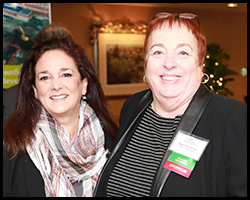
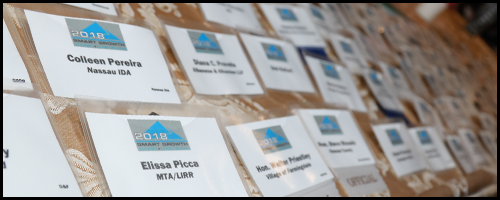
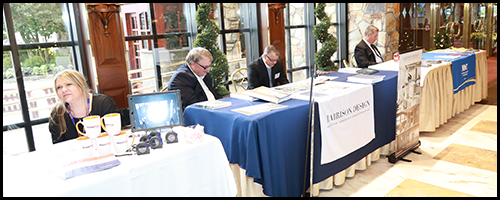
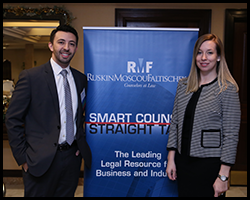

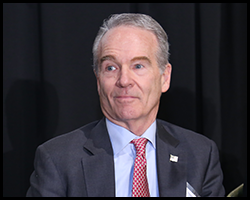







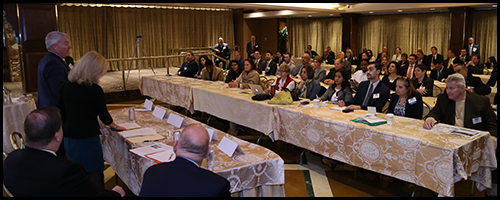

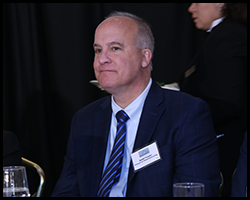
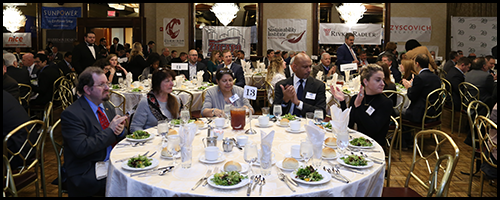

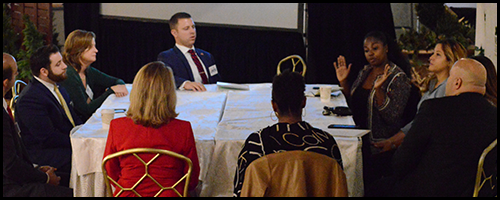


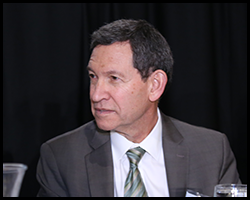



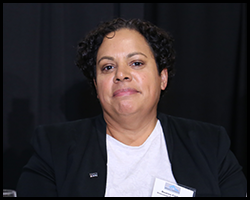


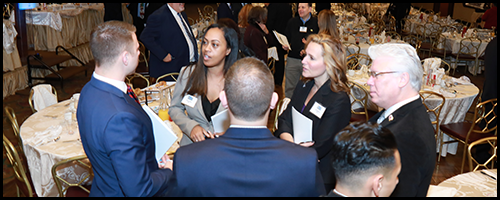

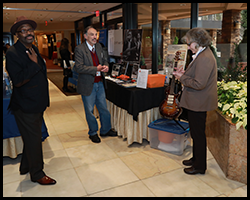
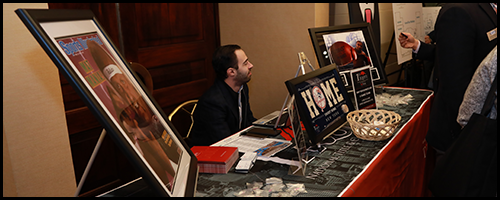
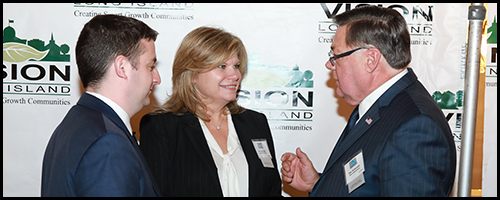
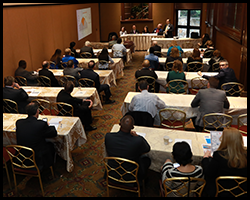


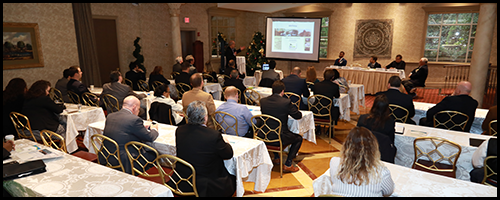
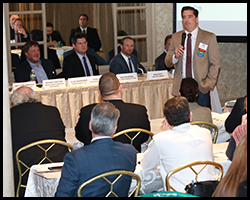
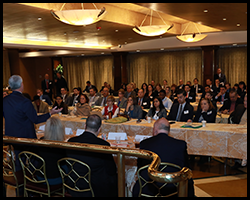

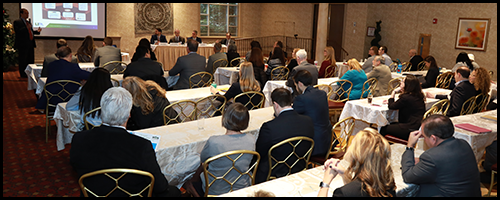

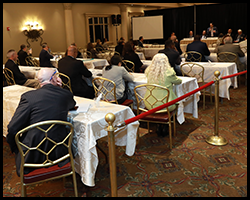
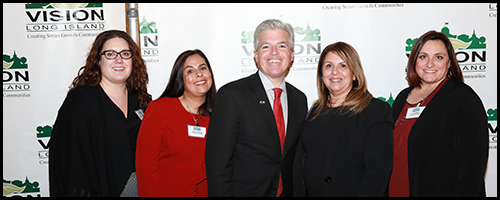

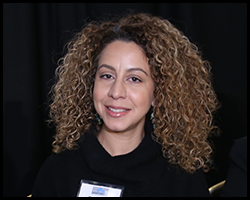
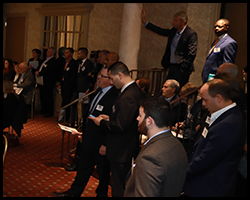


Here is select press coverage
for the 17th Annual Summit!
Read pre-coverage for the event at
Long Island Business News here.
Read our Op-Ed in Long Island Business News
about the themes of the Summit here.

Read pre-coverage of the event at InnovateLI here.
Check back for coverage from News 12,
the Long Island Herald,
Times Beacon Network, Noticia, and more!
We are now accepting nominations for
the 2019 Long Island Smart Growth Awards!
You can view a printable version of the flyer here.
Save the Date for
the 2019 Long Island Smart Growth Summit!
Friday, December 6th, 2019

Vision Long Island
24 Woodbine Ave., Suite Two
Northport, NY 11768
Phone: 631-261-0242. Fax: 631-754-4452.
Email: info@visionlongisland.org
Website: www.visionlongisland.org
 |
|
Home | Contact Us | Newsletter Archive | Donate | About Us



